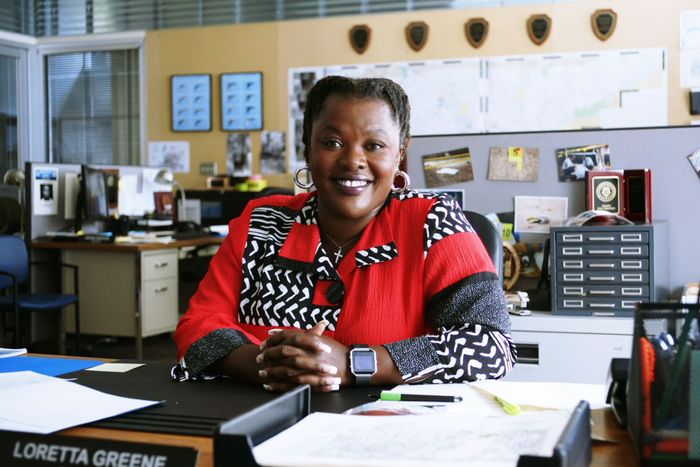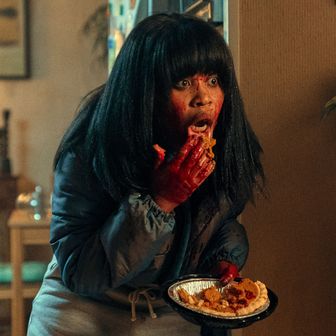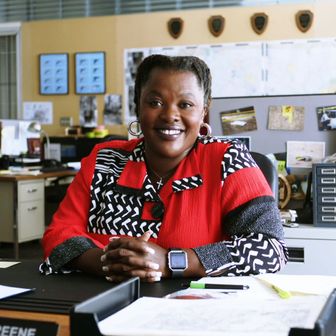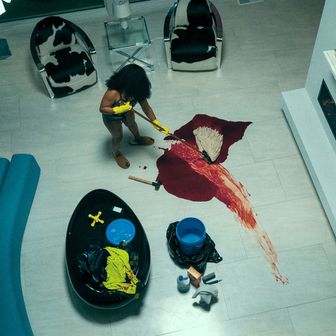
Swarm is a feverish show, a liquid nightmare that obscures and provokes. To achieve this feeling, Janine Nabers and Donald Glover’s series about a murderous obsessive generally opts for a heightened visual aesthetic. Grainy and lush, it’s naturalistic, but only to a point — this is a show that continuously drifts into madness, after all.
Which makes the Prime Video series’ sixth and penultimate entry, “Fallin’ Through the Cracks,” such a hard cut. After tightly sticking to Dre’s (Dominique Fishback) perspective through the previous five installments, culminating in Dre narrowly escaping her former foster parents after invading their home, Swarm takes a breather before the finale. Recalling Atlanta’s penchant for abruptly breaking away to focus on entirely new characters, “Fallin’ Through the Cracks,” written by Karen Joseph Adcock and Stephen Glover, takes the form of a faux true-crime docuseries about a detective, Loretta Greene (Heather Simms), who pieces together the connection between Dre’s geographically disparate murders. Beyond the change in perspective, the episode marks a shift in tone — more overtly humorous, with Loretta playing to the camera like it’s her big break — and a visual aesthetic approximating the pleathery “premium-ish” look of so many Netflix docs.
The “documentary episode” is a fairly well-exercised trope in scripted television. The X-Files’ seventh-season episode “X-Cops” featured a truly excellent stylistic crossover with the Fox reality hit COPS, while the aggressively meta Community, of which Glover is an alum, played with the framing device several times across its run. Much of the tactic’s pleasure lies in its ability to offer audiences new ways to “see” the world of the show, allowing the creative team to flex their mastery over another set of conventions while eliciting chuckles of recognition from a knowing viewer. In Swarm, which already establishes a porous relationship between reality and fiction, the trope is used for further disorienting effect: “Fallin’ Through the Cracks” ends with a cheeky move, displaying images of “Andrea Greene” — a person who is not the character played by Dominique Fishback — and real-life red-carpet footage of Donald Glover talking about directing this very show. It’s a fun bit of meta-textual chaos, establishing the Swarm we’ve been watching as an adaptation of Dre’s real-life story within the faux doc’s universe and adding some extra flesh to the introductory card declaring, “This isn’t a work of fiction.”
It’s a similar move to Atlanta’s own faux doc “The Goof Who Sat by the Door,” an alt-universe history behind the 1995 animated Disney film A Goofy Movie. Written by Adcock and Francesca Sloane and directed by Glover, “Goof” is one of Atlanta’s greatest creations, near-perfectly mimicking the PBS documentary style to tell the story of a young Black animator named Thomas Washington (Eric Berryman) who accidentally becomes Disney CEO following a Putney Swope–esque bureaucratic hiccup and endeavors to create what Black millennials nowadays claim, both jokingly and seriously, as the Blackest movie of all time.
To a large extent, both Swarm and “Goof” are about individuals consumed totally by art and its representational power to destructive outcomes. “[Ni’Jah’s] not like everybody else. She knows what we’re thinking and gives it a name. She’s a goddess,” says Dre, who stalks and kills anyone who dares besmirch her idol’s name. Washington becomes so obsessed with making A Goofy Movie “for the culture” that his family ties fray and he becomes undone when corporate machinations get in the way. Both “Goof” and “Fallin’ Through the Cracks” allow their shows to play around with the thin boundaries between their respective fictional universes and our own, jolting viewers into heightened attention. If Atlanta’s Justin Bieber is Black, what other possibilities are suggested within this world?
Despite this playfulness with the fourth wall, “Fallin’ Through the Cracks” is one of Swarm’s weaker installments. Loretta Greene is a fantastic character — there’s enough there for an entirely new show — but the episode is heavy on gap-filling exposition, even as it needles the desire for explanation around a violently obsessive character like Dre. It recalls a meta-joke from Community’s “Intermediate Documentary Filmmaking,” in which Abed (Danny Pudi) comments, “It’s easier to tell a complex story when you can cut to people explaining things to the camera.” If you’re the sort of logic-minded viewer who takes issue with a plot’s believability, you might’ve wondered how Dre’s been getting away with all that carnage, and “Fallin’ Through the Cracks” provides plenty of explanation. But Swarm isn’t a show primed for that kind of reading. This is a work that leans into the subjectivities of its central character, evident in its ambiguous final scene and capacity to inspire all sorts of interpretative theories. “Fallin’ Through the Cracks” does provide an answer to questions of believability with a dark joke that doubles as insight spelled out for the viewer: Much in the same way Black women are often treated as invisible within the context of victimhood, here’s a Black woman being treated as invisible despite being a prolific killer. It’s a clever thematic quip, but also a disruptive piece of hand-holding for a show heretofore luxuriating in ambiguity.
Ultimately, the reason the mockumentary pursuits of “Fallin’ Through the Cracks” don’t work as well as “Goof” relates to the series’ internal structures. Swarm is a limited series running across seven half-hour-ish episodes, so the faux doc takes up a considerable portion of what had been a fairly tight show. By the time Atlanta arrives at “Goof” late in its fourth season, the show has already established itself as a production philosophically interested in departing from its protagonists to take on different shapes and characters. The sharp break of “Fallin’ Through the Cracks” raises the question: Was this the most interesting way for the show to convey what it wanted with this episode? Deployed against the context of Swarm’s overarching opacity as a text, the gambit feels too dissonant as an explanatory vessel. Then again, how else do you get to that fascinating final turn with the real-world Donald Glover footage, which mischievously underscores the production’s uncanny relationship with reality and emphasizes its commentary on real-world stans?
In the end, Swarm’s sixth episode leans too heavily on a function of the format. By temporarily breaking form to rearrange its relationship with the viewer, the docu-trope gives a show the contained space to reassert its fundamental ideas. For Atlanta, “Goof” condenses many of the series’ prevailing concerns: What does it mean to be a Black show, and part of Black culture, within a predominantly white media and cultural landscape? Meanwhile, “Fallin’ Through the Cracks” makes clear how Swarm perceives the function of its central character and ultimately hollows out her significance. In a scene late in the episode, Roberta Kirby, the social worker who handled Dre’s adoption, pushes back against the documentarian’s insistence on finding a psychological explanation for her violence. “You need there to be a reason she was so messed-up, so you don’t have to sweep your own front door and realize that you are just as flawed,” she says. “I’m not going to help you judge her for something you can’t understand.” Here, Swarm seems to plainly spell out its intention for audiences to use Dre as a mirror to check their own relationship with fandom. But the choice to wave away any deeper attempt to parse the interiority of a person who’d kill in a celebrity’s name — preferring instead to render her purely as a phenomenon — undermines a series that already spent so much time with the character. Swarm is a show that obscures and provokes, but often feels like it’s obscuring a definitive statement behind that provocation.
More From This Series
- 15 Emmy-Worthy Performances That Shouldn’t Be Overlooked
- Let’s Talk About the Black Madwoman in Swarm
- Swarm’s Heather Simms Thinks Detective Greene Is Still Looking for Dre








